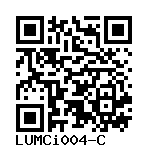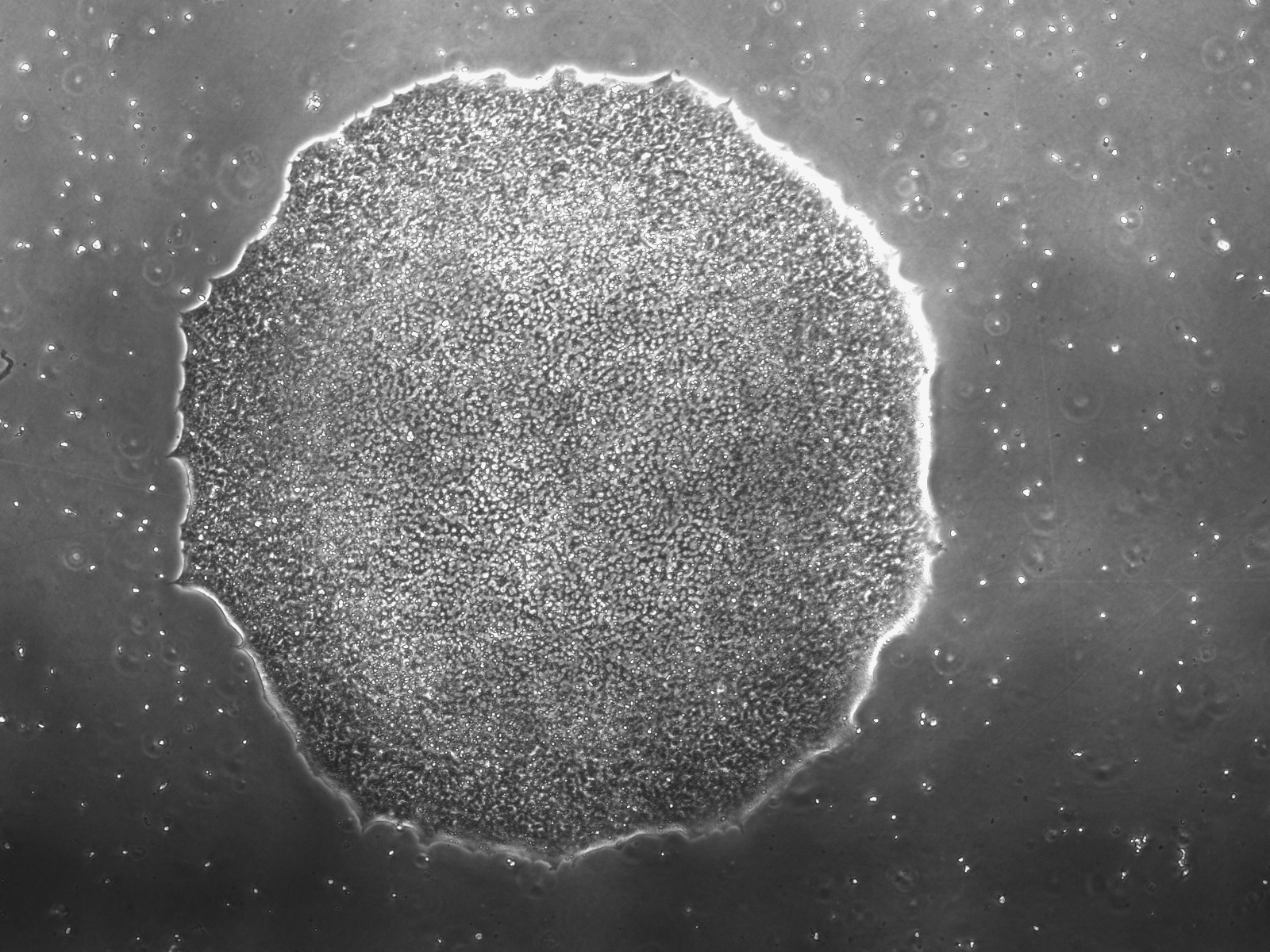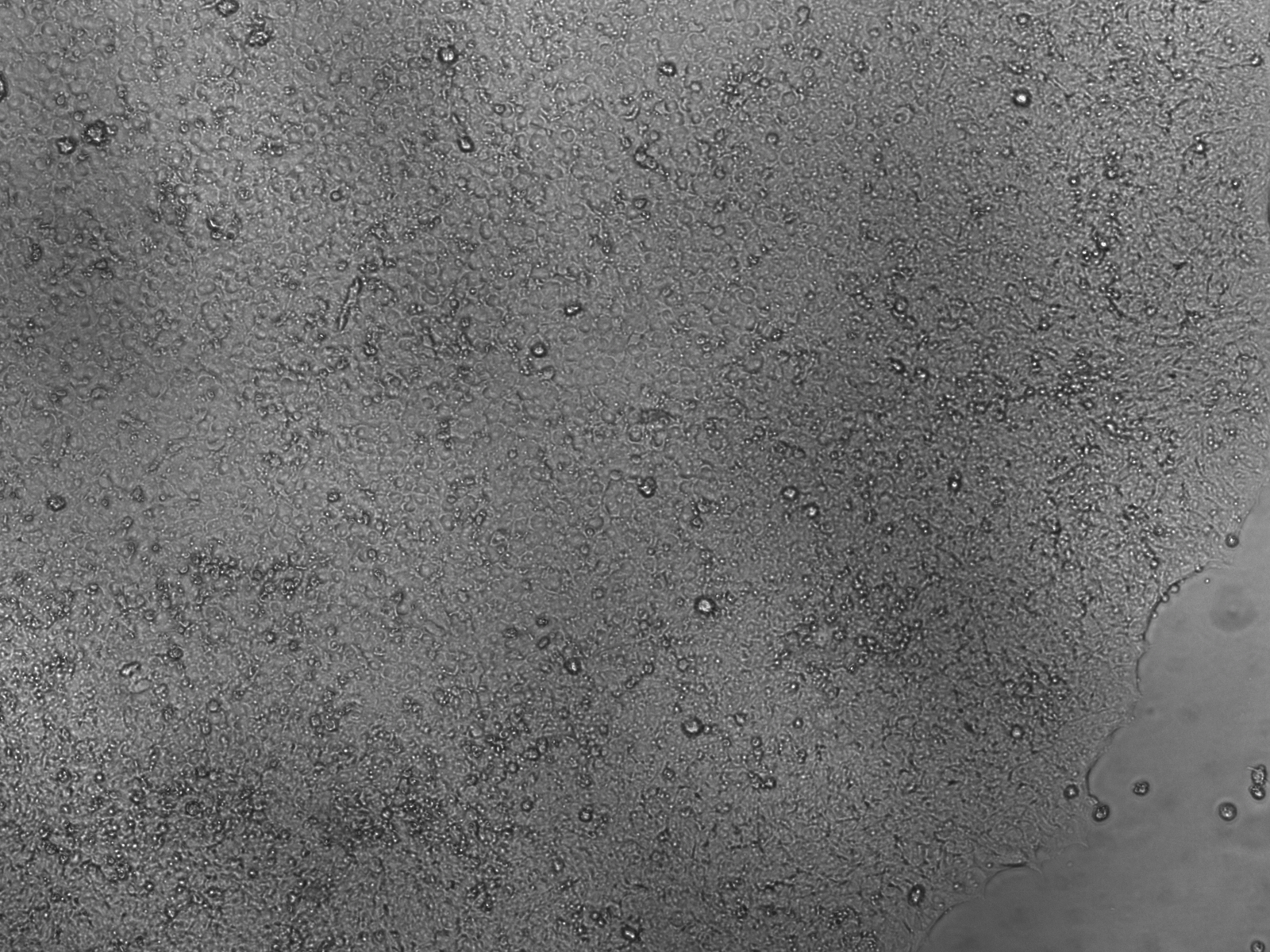LUMC0031iCTRL08
LUMCi004-C
General
Cell Line |
|
| hPSCreg name | LUMCi004-C |
| Cite as: | LUMCi004-C (RRID:CVCL_ZA01) |
| Alternative name(s) |
LUMC0031iCTRL08
|
| Cell line type | Human induced pluripotent stem cell (hiPSC) |
| Similar lines |
LUMCi004-A (LUMC0099iCTRL04) LUMCi004-B (LUMC0030iCTRL12) LUMCi004-A-1 (LU99_AAVS1-bxb-v2) LUMCi004-A-2 (LU99_CLYBL-bxb-v2) |
| Last update | 2nd June 2022 |
| User feedback | |
Provider |
|
| Generator |
Leiden University Medical Center (LUMC)
Contact:
LUMC hiPSC core facility |
| Owner | LUMC hiPSC core facility |
| Distributors | |
| Derivation country | Netherlands |
External Databases |
|
| BioSamples | SAMEA6880363 |
| Cellosaurus | CVCL_ZA01 |
| Wikidata | Q98127052 |
General Information |
|
| Publications |
|
| Projects | |
| * Is the cell line readily obtainable for third parties? |
Yes Research use: allowed
Clinical use: not allowed
Commercial use: allowed
Additional restrictions:
For commercial use, a licence must be obtained for the reprogramming vector |
Donor Information
General Donor Information |
|
| Sex | female |
| Ethnicity | caucasian |
Phenotype and Disease related information (Donor) |
|
| Diseases | No disease was diagnosed.
|
| Family history | No |
| Is the medical history available upon request? | No |
| Is clinical information available? | No |
Karyotyping (Donor) |
|
| Has the donor karyotype been analysed? |
No
|
Other Genotyping (Donor) |
|
| Is there genome-wide genotyping or functional data available? |
No
|
Donor Relations |
|
| Other cell lines of this donor | |
External Databases (Donor) |
|
| BioSamples | SAMEA5032583 |
Ethics
| Has informed consent been obtained from the donor of the embryo/tissue from which the pluripotent stem cells have been derived? | Yes |
| Was the consent voluntarily given? | Yes |
| Has the donor been informed that participation will not directly influence their personal treatment? | Yes |
| Can you provide us with a copy of the Donor Information Sheet provided to the donor? | Yes |
| Do you (Depositor/Provider) hold the original Donor Consent Form? | Yes |
| Is there other documentation provided to the donor for consenting purposes? | No |
| Confirm that consent was obtained by a qualified professional | Yes |
| Has the donor agreed to be re-contacted? | Yes |
| Has the donor been informed about how her/his data will be protected? | Yes |
| Please indicate whether the data associated with the donated material has been pseudonymised or anonymised. | pseudonymised |
| Does consent explicitly allow the derivation of pluripotent stem cells? | Yes |
| * Does consent pertain to a specific research project? | No |
| Does consent permit unforeseen future research, without further consent? | Yes |
| Does the consent permit uses of donated embryo/tissue or derived cell line intended for clinical treatment or human applications? | No |
| Does consent expressly prevent development of commercial products? | No |
| Does consent expressly prevent financial gain from any use of the donated embryo/tissue, including any product made from it? | No |
| Does consent expressly permit storage of donated embryo/tissue for an unlimited time? | Yes |
| Does consent expressly permit storage of cells derived from the donated embryo/tissue for an unlimited time? | Yes |
| Does consent prevent the DONATED BIOSAMPLE from being made available to researchers anywhere in the world? | No |
| Does consent prevent CELLS DERIVED FROM THE DONATED BIOSAMPLE from being made available to researchers anywhere in the world? | No |
Does consent permit research by | |
| an academic institution? | Yes |
| a public organisation? | Yes |
| a non-profit company? | Yes |
| a for-profit corporation? | Yes |
| Does consent expressly permit collection of genetic information? | Yes |
| Does consent expressly permit storage of genetic information? | No |
| Does consent prevent dissemination of genetic information? | No |
| Has the donor been informed that their donated biosample or derived cells may be tested for the presence of microbiological agents / pathogens? | No |
| Has the donor consented to receive information discovered during use of donated embryo/tissue that has significant health implications for the donor? | Yes |
| How may genetic information associated with the cell line be accessed? | No information |
| Will the donor expect to receive financial benefit, beyond reasonable expenses, in return for donating the biosample? | No |
| Does the consent anticipate that the donor will be notified of results or outcomes of any research involving the donated samples or derived cells? | No |
| Does the consent permit the donor, upon withdrawal of consent, to stop the use of the derived cell line(s) that have already been created from donated samples? | Yes |
| Does the consent permit the donor, upon withdrawal of consent, to stop delivery or use of information and data about the donor? | Yes |
| Has a favourable opinion been obtained from a research ethics committee, or other ethics review panel, in relation to the Research Protocol including the consent provisions? | Yes |
| Name of accrediting authority involved? | LUMC Medical Ethics Committee |
| Approval number | Paraplu Protocol P13.080 |
| Has a favourable opinion been obtained from a research ethics committee, or other ethics review panel, in relation to the PROPOSED PROJECT, involving use of donated embryo/tissue or derived cells? | Yes |
| Name of accrediting authority involved? | LUMC Medical Ethics Committee |
| Approval number | Paraplu Protocol P13.080 |
| Do you have obligations to third parties in regard to the use of the cell line? | Yes |
| Please describe: | For commercial use, a license for the reprogramming vector must be obtained. |
| Are you aware of any further constraints on the use of the donated embryo/tissue or derived cells? | No |
| Is there an MTA available for the cell line? | Yes |
| For generation of the cell line, who was the supplier of any recombined DNA vectors or commercial kits used? | Okita et al. Nat methods, 2011. |
| Are you aware of any constraints on the use or distribution of the cell line from the owner or any parties identified in the query above? | Yes |
| Constraints for use or distribution | For commercial use, a license for the reprogramming vector must be obtained. |
hIPSC Derivation
General |
|
| Source cell line name | WK12022 |
| Source cell type |
An excreta material which is composed primarily of urine, a liquid excreta containing water and waste products made by the kidneys, stored in the bladder, and leaves the body through the urethra.; ENVO bodily fluid classes differ from UBERON's treatment of bodily fluids. UBERON refers to the substance itself ("S"). We assert that UBERON's classes are the primary compositional component of the terms in ENVO ("S material"). Use of the ENVO terms is typically recommended when you wish to indicate that there may be other materials intermixed with S.
|
| Source cell origin |
The fluid that is excreted by the kidneys. It is stored in the bladder and discharged through the urethra.
Synonyms
|
| Source cell type (free text) | Urine-derived-cells. |
Reprogramming method |
|
| Vector type | Non-integrating |
| Vector | Episomal |
| Genes | |
| Is reprogramming vector detectable? |
Unknown |
| Vector map | |
Vector free reprogramming |
|
| Type of used vector free reprogramming factor(s) |
None
|
Other |
|
| Selection criteria for clones | Morphology |
| Derived under xeno-free conditions |
No |
| Derived under GMP? |
No |
| Available as clinical grade? |
No |
Culture Conditions
| Surface coating | Vitronectin |
| Feeder cells |
No |
| Passage method |
Enzyme-free cell dissociation
Gentle Cell Dissociation Reagent
|
| CO2 Concentration | 5 % |
| Medium |
TeSR™ E8™
|
| Has Rock inhibitor (Y27632) been used at passage previously with this cell line? | No |
| Has Rock inhibitor (Y27632) been used at cryo previously with this cell line? | No |
| Has Rock inhibitor (Y27632) been used at thaw previously with this cell line? | No |
Characterisation
Analysis of Undifferentiated Cells
| Marker | Expressed | Immunostaining | RT-PCR | Flow Cytometry | Enzymatic Assay | Expression Profiles |
| POU5F1 (OCT-4) |
Yes |
|||||
| TRA 1-81 |
Yes |
|||||
| NANOG |
Yes |
|||||
| SSEA-4 |
Yes |
Differentiation Potency
In vitro spontaneous differentiation
| Marker | Expressed |
| alpha fetoprotein (AFP) |
Yes |
Protocol or reference
In vitro spontaneous differentiation
| Marker | Expressed |
| beta-III tubulin |
Yes |
Protocol or reference
Microbiology / Virus Screening |
|
| Mycoplasma | Negative |
Genotyping
Karyotyping (Cell Line) |
|
| Has the cell line karyotype been analysed? |
Yes
46, XX
Passage number: 16
Karyotyping method:
G-Banding
|
Other Genotyping (Cell Line) |
|




Login to share your feedback, experiences or results with the research community.